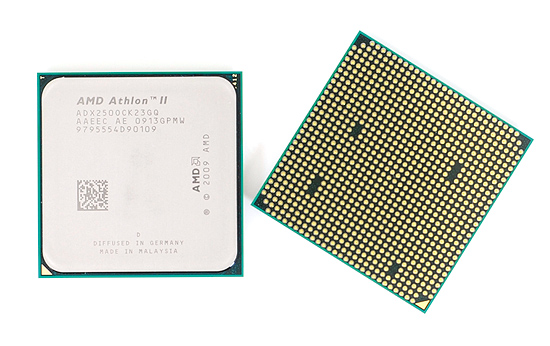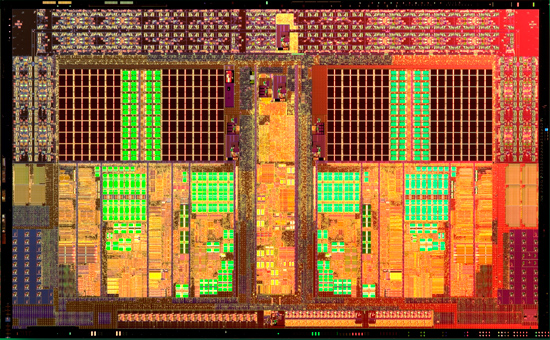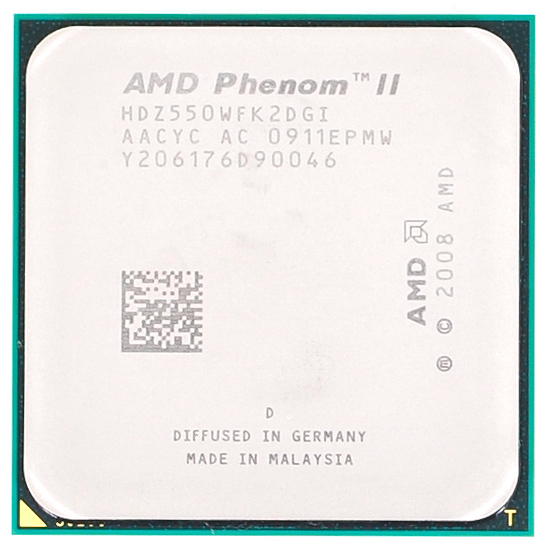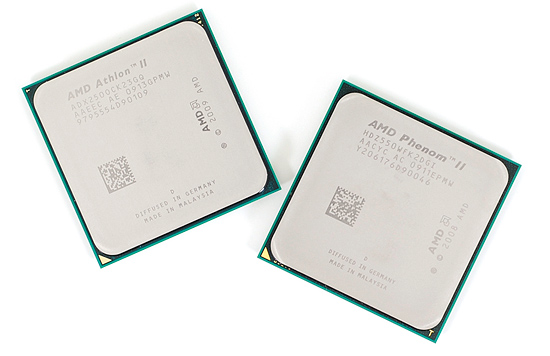The Athlon II X2 & Phenom II X2: 45nm Dual-Core from AMD
by Anand Lal Shimpi on June 2, 2009 12:00 AM EST- Posted in
- CPUs
“AMD in many cases delivers greater performance than the similarly priced Intel CPUs, but not nearly a large enough performance gap to make up for the difference in die size. Again, great for consumers, but potentially painful for AMD in the long run. As yields improve AMD should be able to make more of these cores members of the 900 family, but without a separate, smaller die there will still be economic inefficiencies at the lower end.”
“AMD’s Phenom II is very competitive, but the strategy does not have much long term staying power. AMD needs to introduce smaller die versions of its CPUs soon.”
Ask and you shall receive, right?
Intel did a bang up job tarnishing the Pentium name with its clock speed rampage during the Pentium 4 days, but the Athlon brand still holds a special place in our hearts.
This is the Athlon II, and it’s exactly what I’ve been asking for:

The Athlon II X2, to be specific, is a 45nm monolithic dual-core processor. While the most recent Athlon X2s are derivatives of the original Phenom architecture, the Athlon II is based on the new and improved Phenom II architecture.

The name lives on
Take two Phenom II cores, increase their L2 caches to 1MB, leave out the L3 and you’ve got an Athlon II. The entire die measures only 117.5 mm^2 and is made up of a meager 234 million transistors. The table below compares the Athlon II’s die size to other competing parts:
| Processor | Cores | Manufacturing Process | L1 Cache | L2 Cache | L3 Cache | Die Size | Transistor Count |
| AMD Phenom II X2 | 2 | 45nm | 128KB per core | 1MB | 6MB | 258 mm2 | 758M |
| AMD Athlon II X2 | 2 | 45nm | 128KB per core | 1MB per core | 0MB | 117 mm2 | 234M |
| AMD Athlon X2 | 2 | 65nm | 128KB per core | 512KB per core | 2MB | 285 mm2 | 450M |
| AMD Athlon 64 X2 | 2 | 65nm | 128KB per core | 512KB per core | 0MB | 126 mm2 | 154M |
| Intel Pentium for Desktop | 2 | 45nm | 64KB per core | 2MB | 0MB | 82 mm2 | 228M |
The new Athlon II is actually AMD’s smallest dual core processor ever, even smaller than the original Athlon 64 X2. It’s also AMD’s first 45nm dual-core processor. It’s also AMD’s first Socket-AM3 processor to carry the Athlon brand (ok, I’ll stop). As an AM3 chip it will work in both AM3 and AM2+ motherboards, just like the Phenom II.
The Athlon II is only launching with one model today the 3.0GHz Athlon II X2 250. Priced at $87, it’s likely that we won’t see more Athlon II X2s until AMD is ready to further switch its lineup over to 45nm in order to keep up with demand.
The Phenom II X2 550 BE
We actually get two new dual-core chips today, the second is the new Phenom II X2 550 Black Edition. Like all of the other chips in the Phenom II lineup, the X2 550 is simply a die-harvested Phenom II X4 part. In other words, what we have is a quad-core Phenom II with two of its cores disabled. Given that it’s still fairly early in GlobalFoundries’ 45nm manufacturing process, it makes sense to see so many harvested parts. I would expect these Phenom II X2 and perhaps even the X3 derivatives to either disappear or shift out of the limelight as AMD’s yields improve.

Because it’s based on the quad-core Phenom II processor, the X2 550 BE has a full 6MB L3 cache that the two cores can share. The L2 caches are still stuck at 512KB but with a large 6MB L3, there’s very little to complain about. The unlocked Black Edition part runs at 3.1GHz and retails for $102.
Availability and New Energy Efficient Phenom IIs
AMD is expecting availability for both of these parts in the next week or so.

The table below shows AMD’s new lineup with these two chips. Note that I’ve also included data on the Phenom II X4 905e and the Phenom II X3 705e. These two CPUs run at 2.5GHz and have a 65W TDP, down from 125W and 95W for all previous AM3 parts.
| Processor | Cores | Clock Speed | un-core Clock | L2 Cache | L3 Cache | TDP | Price |
| AMD Phenom II X4 955 BE | 4 | 3.2GHz | 2.0GHz | 2MB | 6MB | 125W | $245 |
| AMD Phenom II X4 945 | 4 | 3.0GHz | 2.0GHz | 2MB | 6MB | 125W | $225 |
| AMD Phenom II X4 940 BE | 4 | 3.0GHz | 1.8GHz | 2MB | 6MB | 125W | $225 |
| AMD Phenom II X4 920 | 4 | 2.8GHz | 1.8GHz | 2MB | 6MB | 125W | $195 |
| AMD Phenom II X4 910 | 4 | 2.6GHz | 2.0GHz | 2MB | 6MB | 95W | $??? |
| AMD Phenom II X4 905e | 4 | 2.5GHz | 2.0GHz | 2MB | 6MB | 65W | $195 |
| AMD Phenom II X4 810 | 4 | 2.6GHz | 2.0GHz | 2MB | 4MB | 95W | $175 |
| AMD Phenom 9950 | 4 | 2.6GHz | 2.0GHz | 2MB | 2MB | 140W | $173 |
| AMD Phenom II X4 805 | 4 | 2.5GHz | 2.0GHz | 2MB | 4MB | 95W | $??? |
| AMD Phenom II X3 720 BE | 3 | 2.8GHz | 2.0GHz | 1.5MB | 6MB | 95W | $145 |
| AMD Phenom II X3 710 | 3 | 2.6GHz | 2.0GHz | 1.5MB | 6MB | 95W | $125 |
| AMD Phenom II X3 705e | 3 | 2.5GHz | 2.0GHz | 1.5MB | 6MB | 65W | $125 |
| AMD Phenom II X2 550 BE | 2 | 3.1GHz | 2.0GHz | 1MB | 6MB | 80W | $102 |
| AMD Athlon II X2 250 | 2 | 3.0GHz | 2.0GHz | 2MB | 0MB | 65W | $87 |
| AMD Athlon X2 7850 | 2 | 2.8GHz | 1.8GHz | 1MB | 2MB | 95W | $69 |
And just for kicks here's a specs table with both AMD and Intel CPUs in it:
| Processor | Cores | Manufacturing Process | L1 Cache | L2 Cache | L3 Cache | Die Size | Transistor Count |
| AMD Phenom II X4 | 4 | 45nm | 128KB per core | 2MB | 6MB | 258 mm2 | 758M |
| AMD Phenom II X3 | 3 | 45nm | 128KB per core | 2MB | 6MB | 258 mm2 | 758M |
| AMD Phenom II X2 | 2 | 45nm | 128KB per core | 2MB | 6MB | 258 mm2 | 758M |
| AMD Athlon II X2 | 2 | 45nm | 128KB per core | 1MB per core | 0MB | 117 mm2 | 234M |
| AMD Athlon X2 | 2 | 65nm | 128KB per core | 512KB per core | 2MB | 285 mm2 | 450M |
| AMD Athlon 64 X2 | 2 | 65nm | 128KB per core | 512KB per core | 0MB | 126 mm2 | 154M |
| Intel Core i7 | 4 | 45nm | 64KB per core | 256KB per core | 8MB | 263 mm2 | 731M |
| Intel Core 2 Quad | 4 | 45nm | 64KB per core | 12MB | 0MB | 214 mm2 | 820M |
| Intel Core 2 Quad | 4 | 45nm | 64KB per core | 4MB | 0MB | 164 mm2 | 456M |
| Intel Core 2 Duo | 2 | 45nm | 64KB per core | 6MB | 0MB | 107 mm2 | 410M |
| Intel Core 2 Duo | 2 | 45nm | 64KB per core | 3MB | 0MB | 82 mm2 | 228M |
| Intel Pentium | 2 | 45nm | 64KB per core | 2MB | 0MB | 82 mm2 | 228M |










55 Comments
View All Comments
TA152H - Tuesday, June 2, 2009 - link
I agree with almost everything you say, I only have a small caveat.Intel chips will suffer much less from this than AMD, since they have an inclusive cache architecture, and can readily read the information from the L3 cache. I still think AMD has an exclusive cache arrangement, which I really think they should change with regards to the L3 cache for reasons just like the one you mention.
For what's it's worth, Microsoft screwed Intel 14 years back when the Pentium Pro was released. Naturally, Intel got the blame for having miserable 16-bit performance (it was related to segmentation, which was part of all the 16-bit modes, and technical, even 32-bit mode even though it was transparent), because Microsoft told them the world will be 32-bit by then. Of course Windows 95 had a lot of legacy code, and Windows NT, which we called "Not There" at the time, was about as common as a 20 year old virgin in western Europe. So, Intel took the blame, just like AMD is now, despite, once again, Microsoft's incompetence.
Really, if you think about it, the ability to clock the processors differently could be a very useful features, except for the fact Winblows can't use it properly.
Good
TA152H - Tuesday, June 2, 2009 - link
First, I like seeing the Pentium 4s in the benchmarks, it was kind of interesting. They did better than I thought they would, and it makes me even more curious what they would be like on 45nm, since their clock speeds would probably be astronomical (since 45nm has much better power characteristics, and the clock speed limiter on the Pentium 4 was power use/heat).But, anyway, why not use the Pentium 4 670 (3.8 GHz), or Pentium EE 965 Extreme Edition (3.73 GHz) processors? Why use the next to fastest ones?
Don't get me wrong, it was still informative, but I would have liked to see the fastest measured against today's processors, not one step removed. Even so, it was nice to see them, so it's just a minor complaint. I'm looking forward to seeing the Nano.
strikeback03 - Wednesday, June 3, 2009 - link
Might not have had any around. Figure the "best of breed" were the most likely to be either sold or go in a system for some family member when they were no longer needed for comparison duties.ShangoY - Tuesday, June 2, 2009 - link
I am curious as to why the current cheapest Intel quad core were not included in the benches yet you bothered to go grab the previously $999 Pentium 4 and then also included the Phenom X4 940.Gary Key - Tuesday, June 2, 2009 - link
http://www.anandtech.com/bench/default.aspx?b=2">http://www.anandtech.com/bench/default.aspx?b=2 - You can compare them here.Kenzid - Tuesday, June 2, 2009 - link
Does any body know why AMD transistor density is very low compare to Intel? Is this because of Intel High K metal process or the architechture?Goty - Tuesday, June 2, 2009 - link
It's more than likely due to the fact that Intel has much higher cache densities than AMD does. It probably had very little to nothing to do with the actual process (well, beyond the geometry size, that is).TA152H - Tuesday, June 2, 2009 - link
What are you basing that on?Typically, cache is very dense, so you will notice transistor count increasing disproportionately to size as you add cache.
With respect to the Athlon II X2 being larger than the Penryn, that's not really a bad thing, since it does more too; the Penryn needs a memory controller on the chipset that the Athlon II does not.
Kenzid - Tuesday, June 2, 2009 - link
Based on above die size chart. Core2Duo 107mm2 and 410million transistors while Athlon II has only 234million transistors on 117mm2. It's almost half of the number of Intel used on theirs. IMC take that much space?TA152H - Tuesday, June 2, 2009 - link
Well, take a look at the Pentium version, and you'll see the what I was saying about the cache. We both can agree it's the same core, but one has a larger cache.The Pentium is 82 mm2, with 228 million transistors, with a 2.064 megabytes of cache (L1 + L2). But, since 1 megabyte is disabled, it's really 3.064, like the other Wolfdale's have. The 6 MB version of the Core 2 is 107 mm2 with 410 million transistors.
So, you can see that adding 3 MB of cache increased the transistor count by 182 million, but the size by only 25 mm2. Or, in other words, it increased transistors by about 80%, but size by about 31%. So, cache does increase transistor count disproportionately to die size.
Oh, and yes, the IMC is quite large. You can view some of the pictures of the CPU die to see it, but it's far from insignificant in size.